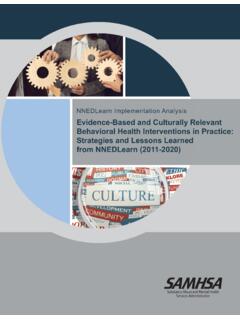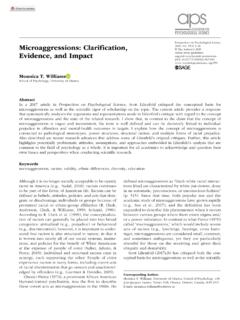Transcription of INTRODUCTION: MULTICULTURALISM IN PSYCHOLOGY …
1 31 introduction : MULTICULTURALISM IN PSYCHOLOGY AND MENTAL health of Multicultural PSYCHOLOGY : Research to Inform Effective Practice, by T. B. Smith and J. E. TrimbleCopyright 2016 by the american Psychological Association. All rights the work of a mental health professional who accepts a new position in a close-knit community with cultural lifestyles very different from mainstream society. The therapist was born and raised far from that commu-nity but had been successful elsewhere. Although the therapist uses the same approach and techniques that had previously worked well, most clients fail to return after the first or second session. The few clients who remain in therapy seem to understand the therapist s intentions and respond to treatment, but reluctantly, the therapist begins to face the fact that the approaches taken in therapy do not align with the experiences and worldviews of most of the new clients.
2 The clients perceive situations in ways unanticipated by the therapist. The clients explanations about emotional events seem peculiar to the thera-pist, who realizes that trying to interpret the clients behavior, feelings, and thoughts often results in misattributions. Desiring to better understand local lifeways and thoughtways and to acquire the skills necessary to implement that understanding, the therapist searches for evidenced-based guidelines Recognizing that all behavior is learned and displayed in a cultural con-text makes possible accurate assessment, meaningful understanding, and appropriate intervention relative to that cultural context. Interpreting behavior out of context is likely to result in misattribution.
3 Paul Pedersen (2008, p. 15)Copyright american Psychological Association4 FOUNDATIONS OF MULTICULTURAL PSYCHOLOGYand resources in the professional mental health literature (G. C. N. Hall & Yee, 2014). Where to begin?MULTICULTURAL PSYCHOLOGY AND COUNSELING: AN OVERVIEWM ulticultural PSYCHOLOGY and counseling is an emerging discipline with the potential to inform therapists of cultural considerations relevant to mental health (Paniagua & Yamada, 2013). It is based on the premise that the ethical provision of mental health services should include an accurate accounting of clients cultural lifeways and thoughtways (Leong, Comas-D az, Hall, McLoyd, & Trimble, 2014; Pedersen, 1999). As an emerging discipline, it has developed guidelines for therapists seeking to be more effective in their work ( american Psychological Association [APA], 2003; G.)
4 C. N. Hall & Yee, 2014; Leong et al., 2014; D. W. Sue & Sue, 2013), and it has become increasingly influential across the mental health professions, most recently in the revised standards for PSYCHOLOGY graduate programs and internships (APA, 2014). Although excep-tions persist, multicultural perspectives are becoming increasingly normative among mental health to what extent are the tenets and guidelines for practice that have arisen from multicultural perspectives based on research evidence? Psychologists and other mental health professionals understand the benefits of using data to inform practice and policy (APA 2005 Presidential Task Force on Evidence-Based Practice, 2006), but to what extent has that occurred? A solid research foundation is essential to the credibility and long-term effectiveness of multi-cultural guidelines for primary purpose of this volume is to summarize research data to inform mental health practices relevant to client race and ethnicity, two delimited aspects of MULTICULTURALISM .
5 Using meta-analytic methods to summarize data in Chapters 2 to 10, the book addresses questions that are fundamental to the discipline. For instance, how large are racial discrepancies in mental health service utilization and client retention, and what factors predict those racial discrepancies? To what degree are perceptions of racism and ethnic iden-tity associated with psychological well-being? To what extent can therapists training in multicultural issues and their level of multicultural competence benefit diverse clients? These are among the key questions relevant not only to the therapist described at the beginning of this chapter but also to every therapist who works in a multicultural improve the effectiveness of their work when they under-stand and apply research data (APA 2005 Presidential Task Force on Evidence-Based Practice, 2006; G.)
6 C. N. Hall & Yee, 2014). The meta-analyses in Copyright american Psychological AssociationINTRODUCTION 5 Chapters 2 through 10 of this book contain interpretations useful for prac-titioners, students, and researchers. Practitioners and students need not be experts in meta-analytic methods to understand the implications of the find-ings, summarized at the end of each chapter. This book emphasizes research findings, but that should benefit, not deter, mental health professionals seek-ing answers. One need not be a researcher to benefit from research. The divide between practitioners and researchers can be bridged. This book attempts to construct a foundation for that bridge, but the reality is that research and practice necessarily inform one another and have been doing so for Historical Overview of MULTICULTURALISM in Mental health ServicesTopics of culture, race, ethnicity, gender, religion and spirituality, sex-ual orientation, and so forth were rarely covered in social science theories and research until the second half of the 20th century.
7 Mental health prac-titioners and scholars often presumed that theories and research findings could be applied to everyone, so they sought to establish universal validity (Dawson, 1971, p. 291). Although they acknowledged that different cultures exist around the world, most concerned themselves almost exclusively with the majority population in their own narrow segment of the global society. And they often reasoned that cultural influences were insufficiently strong to merit serious consideration, let alone merit the time required to gain in-depth familiarity and proficiency across cultures. Culture was seen as a nuance, with the substance of theories and research presumed universal, enduring across rise of multicultural PSYCHOLOGY and counseling in North America came following the expansion of civil rights to historically oppressed popula-tions and paralleled the diversification of the population in the final decades of the last century.
8 Mental health professionals began to realize that although much of human experience is universal ( , we desire companionship and grieve at its loss), interpretations of experience are informed by circumstances, values, and worldviews that differ from culture to culture. It is by no means self-evident that a concept embodied in a theory that has its origins within a particular culture can necessarily be operationalized into a conceptual equiva-lent in a different culture (Jahoda, 1979, p. 143). For instance, child rearing is universally essential to human survival irrespective of culture, but child-rearing practices differ dramatically from one culture to another (Whiting, 1963). PSYCHOLOGY that had ignored cultural differences was guilty of suggestio falsi [because] textbooks and articles commonly implied universality without seeking to provide any grounds for their implicit claims (Jahoda, 1988, p.)
9 93). Multiple factors influence emotional well-being and mental health , and the field gradually began to account for those contextual american Psychological Association6 FOUNDATIONS OF MULTICULTURAL PSYCHOLOGYI nclusion of multicultural perspectives began to spread during the 1970s when increased numbers of women and individuals from diverse backgrounds received graduate degrees in the mental health professions and joined together to form professional associations on multicultural issues. In 1972, for example, a group of psychologists from different countries convened in Hong Kong to criti-cally examine and discuss culture s influence on the human experience (Lonner, 2000). The meeting led to the founding of the International Association for Cross-Cultural PSYCHOLOGY .
10 Two years earlier, the well-established and distin-guished Journal of Cross-Cultural PSYCHOLOGY was launched (Berry, Poortinga, Segall, & Dasen, 1992). Many other organizations with an emphasis on multi-cultural issues also established research journals because mainstream public ations did not represent those considerations. In 1974 the first issue of the Journal of Black PSYCHOLOGY appeared. In 1978, the White Cloud Journal of american Indian/Alaska Native Mental health was founded (and was renamed american Indian and Alaska Native Mental health Research, the Journal of the National Center in 1987). The Hispanic Journal of Behavioral Sciences and the asian american Journal of PSYCHOLOGY were first published in 1979. With publication outlets available, opportunities for scholarship the 1980s and 1990s, the amount of research focusing on multi-cultural issues increased markedly.













